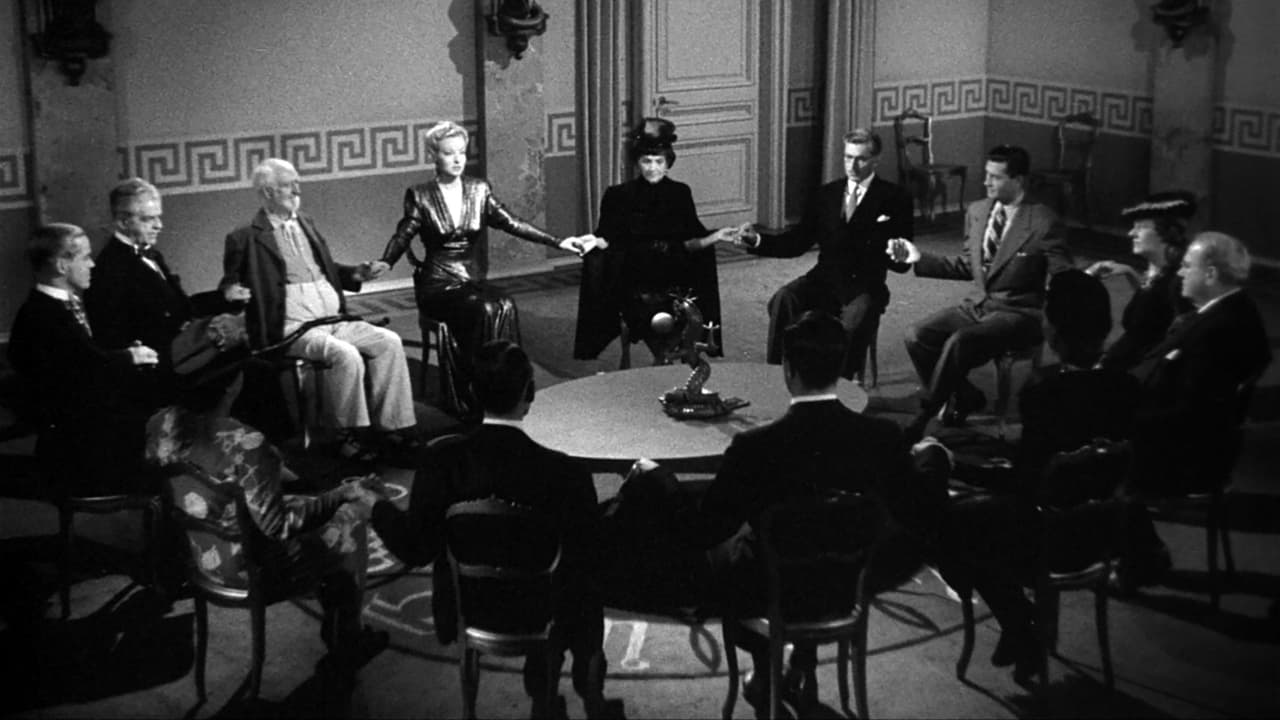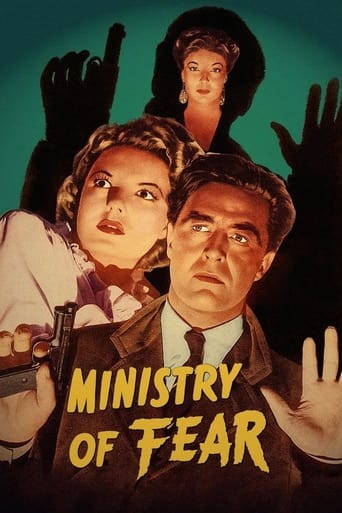Ameriatch
One of the best films i have seen
Freaktana
A Major Disappointment
WillSushyMedia
This movie was so-so. It had it's moments, but wasn't the greatest.
HottWwjdIam
There is just so much movie here. For some it may be too much. But in the same secretly sarcastic way most telemarketers say the phrase, the title of this one is particularly apt.
LeonLouisRicci
Film Buffs, Fans of Director Fritz Lang, and those in the Know Know that Neither Lang or Writer of the Source Material Graham Greene were Not At All Happy with this Movie. But Master Craftsman don't Always Get What They Want in a Collaborative Art, Like Film.Stifled by a Production Team that would Not Allow Lang Full Control Over the Script, He Nevertheless Made an Expressionistic, Dream-Like, War-Time Thriller that is Great to Look at and Includes a Number of Odd Characters and Sets with that Langian Touch.The Fritz Lang Look Overwhelms the Shortcomings of the Script and Story that are Rendered Superficial and Silly At Times and are a Contrast to the Nightmarish Tone. Ray Milland is Like a Deer Caught in the Headlights as He is Suffering from a Two-Year Stay in an Asylum. Released Into a World Where Nothing Seems Quite Right and Instantly is Propelled into a Situation of Impending Intrigue and Double Talk and Double Identities.Overall, it is an Entertaining WWII-Noir that is an Exercise in Style Over Substance with Dan Duryea and Hillary Brooke Along for Some Interesting and Bravura Scenes. Marjorie Lord as the Love Interest is Less Remarkable in a Somewhat Standard Role but She Does Come Through in the Clutches for Some Surprising Action of Her Own.
Claudio Carvalho
In Lembridge, during World War II, the inmate Stephen Neale (Ray Milland) has just been released from the Lembridge Asylum after two years of compulsory confinement. While waiting for the train to London, Stephen visits a charity fair promoted by The Mothers of Free Nations and the clairvoyant Mrs. Bellane gives a tip to him and he receives a cake as a gift.In the train, Stephen shares his cabin with a blind man. Out of the blue, the man steals the cake and run through the field with Stephen chasing him. However, he hides in a house that is bombed by the airplanes and dies.In London, Stephen investigates The Mothers of Free Nations organization and he meets the siblings Carla Hilfe (Marjorie Reynolds) and Willi Hilfe (Carl Esmond) and Stephen goes with Willi to the house of Mrs. Bellane (Hillary Brooke), who is a different woman from the fair. She invites them to participate of a séance and a man is murdered. Stephen is accused and escapes, and Carla finds a hideout to him. Sooner Stephen finds that he is a pawn in a Nazi spy ring and he does not know who is trustworthy."Ministry of Fear" is film-noir of espionage by Fritz Lang with a man getting involved in a spy ring in London during World War II. The plot is only reasonable and the motivation for Stephen Neale to get further and further in his investigation is not clear since he had been advised to avoid problems with the police. Anyway the film is entertaining and for fans of Fritz Lang, it is worthwhile watching it. My vote is seven.Title (Brazil): "Quando Desceram as Trevas" ("When the Darkness Has Fallen Down")
bkoganbing
Paramount did so well with Graham Greene and This Gun For Hire, making a star out of Alan Ladd that they went back to the same source for Ministry Of Fear using one of their best contract leading men Ray Milland as the star. The story starts out remarkably similar to Random Harvest where Milland is an inmate in an asylum.But while Ronald Colman was a shell shocked World War I veteran, Milland was in there for murder. The Code firmly in place said you can't have the hero be a murderer even if it was for a mercy killing of his terminally ill wife. So Paramount cheated the novel by having Milland only by the poison, not use it, and then have the wife find it and use it on herself, according to him. But the authorities arrest him anyway, but he's given a light sentence of two years in a rubber room.All of which make him reluctant to go to the police when some bizarre things start happening. At a bazaar no less when a fake fortune teller tells him to bid on a cake by guessing the weight. He gets the cake, but he's not the one it's intended for. The cake has a microfilm inside and the bazaar was a blind for some nasty enemy spies.We don't know that yet, but when a blind man who Milland shares a compartment with on a train to London knocks him out and steals the cake, Milland and the audience knows something is afoot. This was the part that strained by credulity the most. If the guy wanted the cake so bad, I'd have reported the assault to the police and let the cake go. But Milland doesn't trust the cops, that's understandable, but to chase the thief over the moors while the train is stalled because of a Nazi air attack to me was a bit much.Milland's curiosity sends him investigating the charity that was holding the bazaar and it's one of those refugee charities run by a brother and sister team played by Carl Esmond and Marjorie Reynolds. After that it's wading through a morass of mystery and deciding who's your friend and who's you and your country's foe.Even with Fritz Lang who was second to none in directing psychological thrillers, Ministry Of Fear doesn't succeed half as well as This Gun For Hire. It's all right entertainment, but falls way short of being a classic.
Steffi_P
The United Kingdom has long been the home of the spy thriller. While writers in the US like Dashiell Hammett and Raymond Chandler were turning out hard-boiled crime fiction, Britain had people like John Buchan and Grahame Greene writing adventuresome tales of espionage and political intrigue. In cinema too, the best director of spy thrillers was undoubtedly Englishman Alfred Hitchcock, and many of his early British films were in the genre. Ministry of Fear however was an American production, made by Paramount studios, and yet it is set in Britain and is adapted from a Grahame Greene novel.Despite this complete independence from the famous British thrillers of the 30s (which weren't just Hitchcock's by the way, Michael Powell did a few, as did Anthony Asquith), you can see the similarities in theme and plot. As in The 39 Steps, The Man Who Knew Too Much and so forth, the hero is an ordinary citizen who is drawn into events by chance. He finds himself in a nightmare situation where anyone could be an enemy, and he even finds it impossible to prove his own innocence to the authorities. I stress all this to prove the point that these devices were not invented by Hitchcock, even if he popularised them and associated them with his name – they were established features of the spy novel.Being a US production, and seemingly one unable to take advantage of the growing crop of Brit actors in Hollywood, the primary roles in Ministry of Fear go to Americans. Ray Milland was just starting to break through into important dramatic roles, and although this is far from as prestigious as the ones he would soon be getting, it does show off his talent for moulding a new persona. He does a passable British accent, in the days before getting these things right was considered important (cf. Errol Flynn pretending to be a yankee), and gives a realistic look of disorientation to the character which fits in nicely with his innocent bystander status. The only other standout from the cast is Dan Duryea who despite only appearing in a handful of scenes makes a grand impact. Duryea didn't really play authentic types, but that wasn't the point. He was the archetypal creepy villain, and his characters don't have to be particularly active because he was great at constantly projecting the idea that he might be about to do something unpleasant. Take that scene at the tailor's shop, where he dials the number with a pair of scissors – that's a typical and very effective bit of Duryea business.And finally we come to the director, one Fritz Lang. Lang responds fantastically to the material, and emphasises most of all the sense of entrapment in a nightmarish situation. Take the pivotal cake-weigh scene – who but Lang could make a village fete look so eerie? The child's ball bouncing towards Milland as he enters, the absence of bustle or enjoyment, the silence as Duryea arrives, and the absolute, claustrophobic darkness. It's not just gloomy – it has the surrealism of a dream, and really does feel like some symbolic strand of a nightmare. Also characteristic of Lang is the way he uses odd angles and compositions, not so much for expressionistic value but to satisfy his own aesthetic taste, full of diagonals and art deco starkness. It gives us this sense of displacement as familiar settings and objects become geometric patterns. Hollywood didn't have a lot of cash to spare during the war (for a good example of this check out how minimalist Paramount's "big" Technicolor "epic" of the war years, For Whom the Bell Tolls, is), and oddly enough this fact adds to the effect in Ministry of Fear, with stripped down sets, low-level lighting and a lack of extras making conjuring up the atmosphere of a ghost-town.And this really is what makes Ministry of Fear that little bit different. Whereas the Hitchcock-directed spy thrillers had a kind of playfulness to them, and used that to complement the sense of excitement which the plots necessarily generated from them, Lang's take on the genre really embodies that feeling of real life becoming a nightmare, a tone which Hitch never really went all-out on. As such, Ministry of Fear works on us like a horror movie (and interestingly the theatrical trailer tried to package it as one) thrilling us by immersing us in its chilling world.

